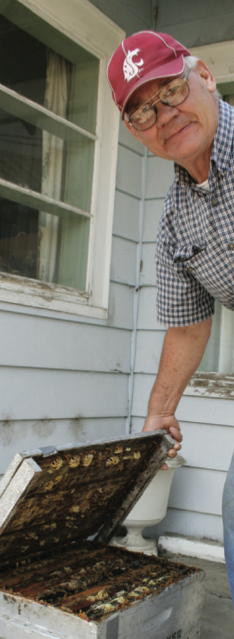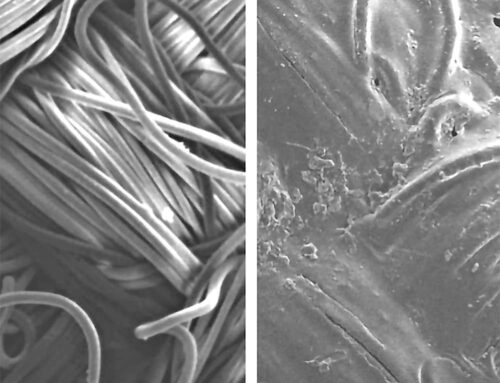
Eric Olson, one of the largest beekeepers in the country, checks a colony containing about 30,000 bees.
Orchardists and beekeepers have responded generously to support Washing- ton State University’s efforts to discover the causes and cures for a phenomenon known as colony collapse disorder, in which worker bees suddenly disappear from colonies. Bee experts say that the disorder, which has caused widespread colony losses, is probably not a single disease with a single cause.
With seed money from two Pacific Northwest beekeepers, WSU launched a diagnostic service early this year to help shed light on the possible causes of unusually high colony losses after the past couple of winters. The diagnostic service is part of WSU’s colony health program, which aims to look at the causes and possible treatments for colony collapse disorder. Eric Olson of Yakima, Washington, is one of the country’s largest beekeepers with around 14,000 hives.
Last winter, he lost 35 percent of his bees, which cost him $1.2 million in lost pollination fees and replacement costs. Beekeepers can’t afford repeated losses of that magnitude, he says. He estimates that between 16 and 18 commercial beekeepers in Washington have gone out of business in the past 10 to 15 years, leaving only eight or nine still supplying bees.
About 70 percent of tree fruit pollination is now done by out-of-state bees, he believes. He and Nampa, Idaho, beekeeper Tom Hamilton each donated $10,000 to WSU and encouraged other Northwest beekeepers and agricultural groups to contribute. “I’m not the kind of person who can sit here and hope for the best.
I want to be more proactive,” he explained. Olson asked his customers to donate $1 per hive and promised to match their donations. Growers responded generously, he said. For example, Zirkle Fruit Company gave $10,000. Other sizable contributions came from the Washington Tree Fruit Research Commission, the Washington State Commission on Pesticide Registration, the Washington State Beekeepers Association, and Washington beekeeper registration fees. The Washington State Governor’s Emergency Fund provided $40,000.
Dead and gone
Olson said it’s no use trying to find the causes of losses when the bees are dead and gone, which is why the colony health program is so important. “If we don’t have this colony health research, we have no chance. In my opinion, it’s our only lifeline. If we don’t find out what’s going on, we’re going to be out of business, and there’s going to be no bees for pollination.
I’m not overstating the case at all.” Since the beginning of the year, the diagnostic center has been testing samples of bees from specific hives each month to monitor the health of hives over time and allow beekeepers to treat them if necessary. Sample bees are checked for parasites, such as the varroa and tracheal mites, and for the diseases Nosema apis and Nosema ceranae, which might be among the causes of colony collapse.
Nosema apis has been affecting bees in the United States for a long time, Olson said. It’s a winter disease that disappears in summer. Nosema ceranae, a more recent introduction with no visible symptoms, is more serious because it can infect bees year round. The two disease species can only be differentiated through molecular analysis. Beekeepers can send samples to the diagnostic center year round. Samples taken this fall will be absolutely critical in identifying what can be done to help the bees survive the winter, Olson said.
Outreach
Rich Zack, chair of WSU’s entomology department, said the university will request funding from the state legislature to continue the colony health program and is hoping to attract grant money. WSU would like to hire an additional person to do outreach and work with beekeepers on a day-to-day basis in the field.
“We’re taking this very seriously,” Zack said. “In Washington, especially, so many of our crops are honeybee pollinated. If you lose honeybees, you’re talking about problems in tree fruits, and cranberries, and the list goes on. Then you start talking about big money and big prob- lems. Right now, this is certainly our number-one program. This is where we’re putting our money.”
Zack said there have been many proposed explanations for colony collapse disorder, and stress may be part of it. Through the diagnostic service, WSU hopes to provide immediate help to beekeepers and growers who rely on bees, and find ways to alleviate the stresses that the bees experience while being trucked from state to state.
Olson said one of the benefits of the diagnostic pro- gram is finding out what’s happening to the bees in time to do something about it. “Up to now, we’ve always been guessing and trying to do the best we can for the bees,” he said. “I’m sick of guessing. I want to know. Already, I know more about my bees today than I have known in my life. Will it stop the losses? I don’t know that, but at least I’m seeing in detail where we’re at, and we are building a baseline of data.”
The diagnostic service should help beekeepers know when to treat their hives for N. ceranae, but it also will help them avoid overusing the antibiotic and manage resistance so it doesn’t lose its efficacy, Olson said. And, based on results of tests for tracheal mites earlier this year, Olson was able to treat his hives only once with menthol instead of three times seven days apart, as he normally would. This reduced his costs, and he also thinks that the single treatment was less stressful to the bees than three treatments.
Meanwhile, WSU apiculturist and geneticist Dr. Steve Sheppard is working on a research project to improve the longterm strength and health of colonies in the Pacific Northwest by developing strains of bees that are genetically better able to handle stresses. “What we’re trying to do is hit this from both angles,” Zack said. “What can we provide to you today, and what can we provide for the longer term that maybe solves this in a much more effective way than a continuation of having to use these pesticides?”




Leave A Comment